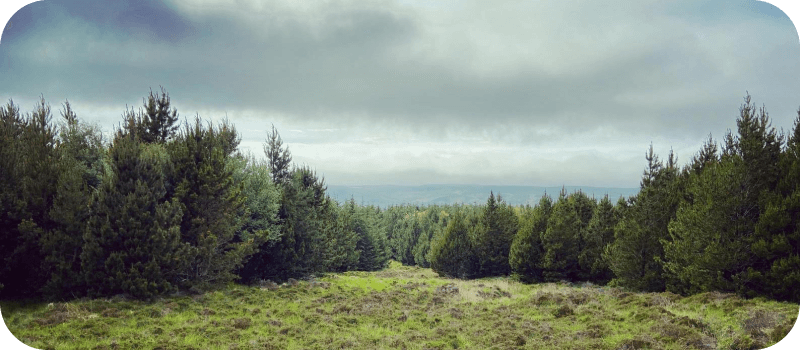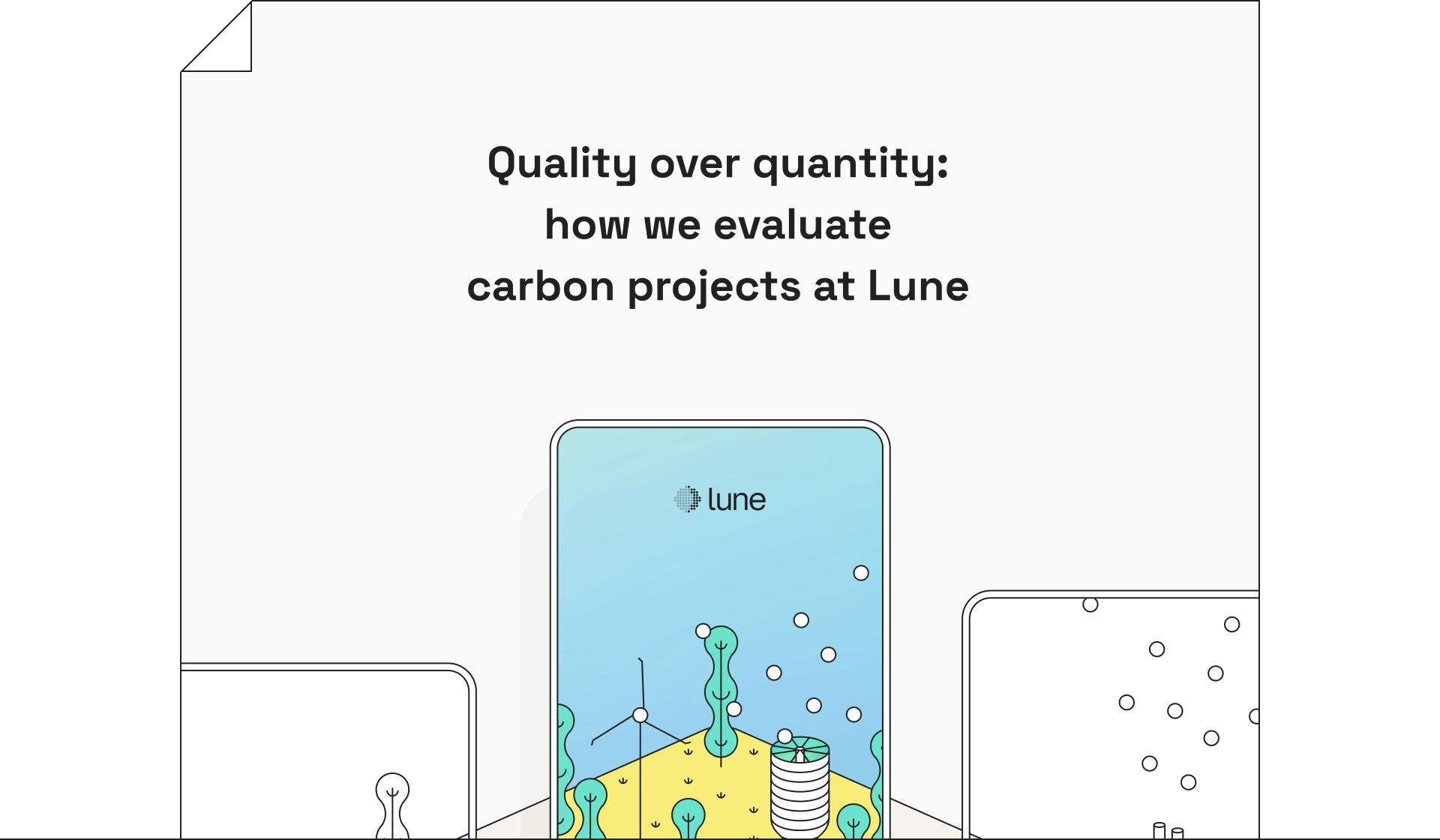

When it comes to choosing which carbon offsets to buy, the choice can be overwhelming – there are just so many projects out there.
Even understanding the different types of projects, and how they work, can be confusing.
It's why at Lune we’ve curated the highest-quality, trusted projects in our library – to help make the evaluation process a little easier for businesses. It’s also why we’re publishing a series of deep dives articles, covering everything you need to know about different types of carbon offset projects, starting with afforestation.
To receive updates when new deep dives are published, sign up to our monthly newsletter.
What is afforestation?
Afforestation is the planting of new trees in an area where there were no trees before, creating a brand new forest which absorbs and stores CO2. And given that we desperately need to lower the amount of carbon in the atmosphere to mitigate global warming, afforestation projects are an important climate solution.
In fact, we asked Harry Grocott and Rob Godfrey, co-founders of Treeconomy, why afforestation projects are vital in the response to climate change, and they came up with several important points:
- Trees are an ancient and reliable carbon removal technology, removing CO2 from the atmosphere – it’s estimated that afforestation and other nature-based solutions can provide roughly 30% of the cost-effective mitigation required to achieve our Paris goals (Griscom et al)
- Afforestation is the lowest-cost technology to actively remove CO2 from the atmosphere, especially when compared to engineered solutions
- Healthy forests also do so much more than just suck carbon out of the air, with numerous important co-benefits which are increasingly important factors to consider as we adapt to climate change. For instance forests are hotbeds of biodiversity, with roughly 80% of terrestrial wildlife being dependent upon forests for survival. They also cool the areas around them and can reduce the size and frequency of flood events.
They did, however, also highlight that not all afforestation projects do provide these benefits. As with any kind of carbon offset, quality is paramount – and we'll discuss what makes a high-quality afforestation project a little later on in this post.

What type of carbon offset is afforestation?
There are many different ways to categorise carbon offset projects.
At Lune, we focus on two key categories, based on the types laid out in the Oxford Offsetting Principles: is it a carbon removal or emissions avoidance project? Is the carbon stored, and if so, is it stored permanently or is there a risk of reversal?
Afforestation projects fit into the Oxford Offsetting Principles type 4 – carbon removal with short-lived storage.
Trees absorb CO2 and remove it from the atmosphere, using it during photosynthesis – sunlight converts CO2 and water into sugar for the tree to use as energy.
CO2 is absorbed and stored during the tree’s lifetime but is released when the tree dies – which can be 100s (even 1000s!) of years if it dies of natural causes, but may be much less if the tree becomes diseased, is cut down, or is victim to a forest fire – so afforestation provides short-lived storage.
What does quality look like in afforestation carbon offset projects?
Quality should be the number 1 focus when deciding which carbon offset projects to support, and it can be a particular issue in forestry projects – there are an abundance of tree planting projects which are cheap, and so appeal to businesses, but actually have minimal positive impact.
Key traits of a high-quality carbon offset project include:
- Permanence
- Additionality
- Correct estimation
- Co-benefits beyond carbon.
So what do these mean in the context of afforestation projects?
Subscribe for the latest insights into driving climate positivity
Permanence
As highlighted above, afforestation projects provide short-lived carbon storage. Therefore, they can’t be said to be providing a completely permanent solution.
In the right conditions, though, trees can live and absorb carbon for hundreds or thousands of years. So a key indicator of quality in afforestation projects is whether they’re enabling those conditions to ensure that the carbon storage is as long-lived as possible.
They should have plans in place to ensure that as many of the trees planted as possible live until a natural death, meaning:
- Careful management of the young saplings to protect them from disease, animal damage, wildfires etc and to ensure they can access the water, nutrients, sunlight etc needed to thrive
- Working with the landowner to minimise risk, particularly that the land the trees are planted on could change ownership or land use in the years and decades to come, to avoid the trees being cut down or damaged once mature.Additionality
Additionality
A project is additional when the carbon benefit is made in addition to what would have happened if the project didn’t issue carbon offset credits.
With afforestation projects, this particularly means proving that without the existence of the project the land would have been used for some other purpose which would not have resulted in carbon removal – typically it would have been agricultural land otherwise.
Correct estimation
Carbon offset projects are paid for each carbon credit they sell, so they have an incentive to claim to be reducing more emissions or removing more carbon than they actually are.
That’s why it’s important that afforestation projects are transparent with their estimation methods, including:
- How they’ve quantified their carbon impact, for instance their calculations on how much carbon each tree absorbs each year
- Evidence that the estimated carbon impact aligns with reality once the trees are planted, for instance if they use monitoring systems to check actual carbon impact.
Many carbon offset forestry projects also only issue their carbon offset credits after the trees have been growing for over 10 years (known as ex-post credits), when carbon removal can be measured and proven.
Co-benefits
As we’ve mentioned already, it’s easy to get tree planting wrong. And that’s true of benefits beyond carbon emissions too – planting new trees can actually be harmful to wildlife and ecosystems if done wrong.
A particular issue to look out for with afforestation projects is ‘monoculture’ i.e. planting a single species of trees in an area. Monoculture forests lack the biodiversity of plants and animals that allow forests to thrive in a natural cycle – meaning that there are typically issues with poor soil, leading to high usage of fertilisers.
On the other hand, when done correctly, planting trees is hugely valuable for the environment in a wider sense. Afforestation projects should be heterogeneous (i.e. diverse, with multiple complementary species of trees), using species of trees native to the area.
When this happens, there are many environmental benefits beyond carbon, including:
- Creating new habitats for wildlife, promoting biodiversity – this requires careful consideration of which species of trees to plant
- Ecosystem benefits such as preventing soil erosion and reducing river run-off (vital for controlling flooding)
- Pollution removal.

Further, afforestation projects can also be hugely beneficial to local communities, particularly through their value as recreational spaces, as well as providing job opportunities – directly in the planting and maintaining the forest, as well as indirectly through tourism opportunities e.g. an ecotourism project at the Keo Seima forest in Cambodia brings an annual income of $14,000 to the local community.
Ackron Mixed: an example of a high-quality afforestation project
Ackron Mixed is an afforestation project in Scotland which took a 40 hectare plot of land which was previously used for sheep grazing and planted trees to create a new forest. It has removed 1,880 tCO2e from the atmosphere since it began back in 2000. It's now managed by Treeconomy, using their monitoring technology to enhance the project's quality.

There are many markers of quality to be found in the Ackron Mixed project:
- Verification: the project is certified by the UK Woodland Carbon Code and verified by Organic Farmers and Growers, a third-party auditor.
- Additionality: The project is highly additional. The land was previously degraded grazing land and would not have sequestered as much carbon absent the active afforestation. Woodland creation was undertaken for the explicit purpose of sequestering carbon and restoring the ecosystem; it is fully reliant upon carbon finance for viability.
- Co-benefits: the forest was planned to promote biodiversity, with a mixture of tree varieties planted to create a mixed native woodland, which would provide a home for threatened species such as short-eared owls and black grouse. Treeconomy's business model also provides a fairer return for landowners, ensuring they are adequately rewarded and fully incentivised – ensuring landowners benefit too, and improving the likelihood of the long-term success of the project.
- Correct estimation: Treeconomy’s remote sensing and satellite technology has been used to accurately determine the carbon stock of the forest i.e. how much CO2 the forest will absorb and store and, therefore, how many carbon credits should be sold. As an example of the importance of this, when Treeconomy first measured the site, they were able to find that there had been an error made in the initial project design on the size of the plot of land – it had been marked as 46.98 hectares, but Treeconomy’s measurements found it to actually be 40.1 hectares, bringing the carbon stock down from 8,322 tCO2 to 7,602 tCO2, an 8.7% decrease. At the same time, they also identified that there were 53% less trees on the site during their tree count (which had previously been done using manual sampling, counting less than 1% of the area). Combined, the two errors were leading to a significant overestimation in carbon stock.
- Regular and in-depth monitoring: Treeconomy’s monitoring technology enables the detail and transparency needed to help with forest management, ensuring the trees thrives and stores as much carbon as possible, as well as providing assurance of the true carbon impact of the project.

Find out more about the Ackron Mixed afforestation project in the Lune dashboard (nb: you’ll need to log-in or sign-up to see the project page).
Plus, if you're curious about our own evaluation process for the carbon projects we include in our library at Lune, take a look at our guide.

Readers also liked
Readers also liked

Subscribe for emissions intelligence insights
Get the latest updates in the world of carbon tracking, accounting, reporting, and offsetting direct to your inbox.


